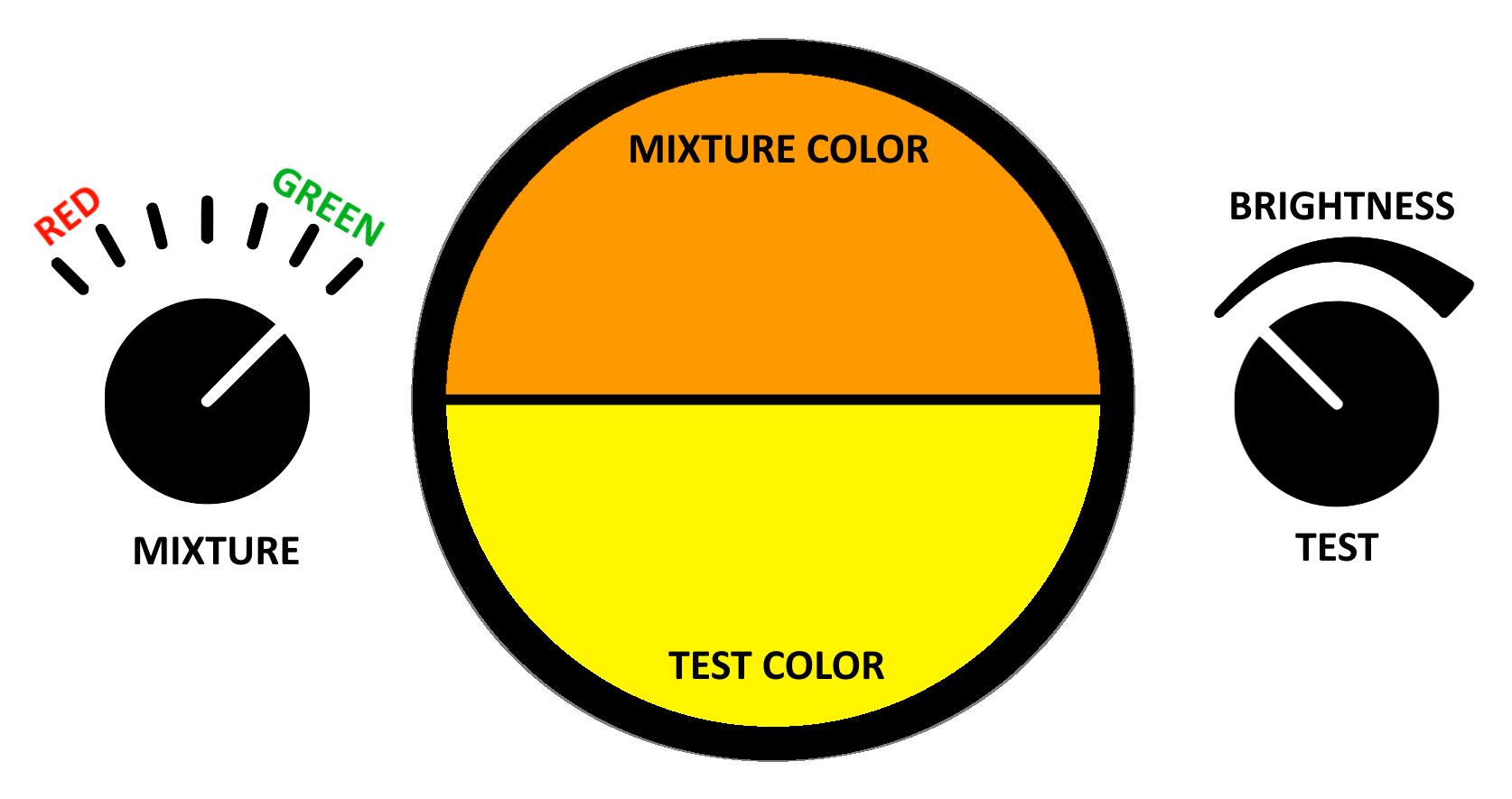|
Holmgren's Wool Test
Holmgren's wool test also known as Holmgren's colored wool test is a color vision test used to detect color vision deficiency. Swedish physiologist Frithiof Holmgren introduced the test in 1874. It was the first successful attempt to standardize the detection of color blindness. William Thomson simplified the original Holmgren test, and later named as Holmgren-Thomson test. History Holmgren's colored wool test is a color vision test method introduced in 1874 by the Swedish physiologist Alarik Frithiof Holmgren (1831-1897). Holmgren studied the electrical response of the retina to light. Holmgren's test gained attention following Lagerlunda rail accident in Sweden in 1875. Suspecting that the train's engineer (who had died in the accident) was color blind, Holmgren decided to examine the 266 employees of the Uppsala Gabole line, and as he suspected, thirteen of them were found to be color blind. Holmgren's test quickly established itself as a systematic and reliable method of dete ... [...More Info...] [...Related Items...] OR: [Wikipedia] [Google] [Baidu] |
Ophthalmology
Ophthalmology (, ) is the branch of medicine that deals with the diagnosis, treatment, and surgery of eye diseases and disorders. An ophthalmologist is a physician who undergoes subspecialty training in medical and surgical eye care. Following a medical degree, a doctor specialising in ophthalmology must pursue additional postgraduate residency training specific to that field. In the United States, following graduation from medical school, one must complete a four-year residency in ophthalmology to become an ophthalmologist. Following residency, additional specialty training (or fellowship) may be sought in a particular aspect of eye pathology. Ophthalmologists prescribe medications to treat ailments, such as eye diseases, implement laser therapy, and perform surgery when needed. Ophthalmologists provide both primary and specialty eye care—medical and surgical. Most ophthalmologists participate in academic research on eye diseases at some point in their training and many inc ... [...More Info...] [...Related Items...] OR: [Wikipedia] [Google] [Baidu] |
Optometry
Optometry is the healthcare practice concerned with examining the eyes for visual defects, prescribing corrective lenses, and detecting eye abnormalities. In the United States and Canada, optometrists are those that hold a post-baccalaureate four-year Doctor of Optometry degree. They are trained and licensed to practice medicine for eye related conditions, in addition to providing refractive (optical) eye care. Within their scope of practice, optometrists are considered physicians and bill medical insurance(s) (example: Medicare) accordingly. In the United Kingdom, optometrists may also provide medical care (e.g. prescribe medications and perform various surgeries) for eye-related conditions in addition to providing refractive care. The Doctor of Optometry degree is rarer in the UK. Many optometrists participate in academic research for eye-related conditions and diseases. In addition to prescribing glasses and contact lenses for vision related deficiencies, optometrists are ... [...More Info...] [...Related Items...] OR: [Wikipedia] [Google] [Baidu] |
Color Vision Test
A color vision test is used for measuring color vision against a standard. These tests are most often used to diagnose color vision deficiencies ("CVD"; color blindness''), though several of the standards are designed to categorize normal color vision into sub-levels. With the large prevalence of color vision deficiencies (8% of males) and the Color blindness#Occupations, wide range of professions that restrict hiring the colorblind for safety or aesthetic reasons, clinical color vision standards must be designed to be fast and simple to implement. Color vision standards for academic use trade speed and simplicity for accuracy and precision. Applications Color vision standards are used to evaluate the color vision of a subject. They are most commonly applied to job applicants during pre-job screening. The evaluation may be to select against the color blindness, color vision deficient for roles where basic color vision is required, or to select for individuals with superior color v ... [...More Info...] [...Related Items...] OR: [Wikipedia] [Google] [Baidu] |
Color Vision Deficiency
Color blindness, color vision deficiency (CVD) or color deficiency is the decreased ability to color vision, see color or differences in color. The severity of color blindness ranges from mostly unnoticeable to full absence of color perception. Color blindness is usually a Sex linkage, sex-linked Heredity, inherited problem or variation in the functionality of one or more of the three classes of cone cells in the retina, which mediate color vision. The most common form is caused by a genetic condition called congenital red–green color blindness (including protan and deutan types), which affects ''up to'' 1 in 12 males (8%) and 1 in 200 females (0.5%). The condition is more prevalent in males, because the opsin genes responsible are located on the X chromosome. Rarer genetic conditions causing color blindness include congenital blue–yellow color blindness (tritan type), blue cone monochromacy, and achromatopsia. Color blindness can also result from physical or chemical dam ... [...More Info...] [...Related Items...] OR: [Wikipedia] [Google] [Baidu] |
Frithiof Holmgren
Alarik Frithiof Holmgren (October 22, 1831 – August 14, 1897) was a Swedish physician, physiologist and professor at Upsala University, most noted for his research of color blindness. He was a vocal opponent of vivisection, and particularly the use of curare to immobilize subjects so they appeared peaceful while enduring great pain. Biography Holmgren was born in Östergötland, Sweden, where his father Anders was rector for the Motala-Vinnerstad parish. One of twelve siblings he studied at Linköping before going to Uppsala in 1850. From 1852 he served as a medical practitioner including during the 1846–1860 cholera pandemic, cholera pandemic in Norrköping and Söderköping. He graduated as a Medical Doctor from Uppsala University in 1861. He went to Vienna and studied under Ernst Wilhelm von Brücke who sent him to work with Carl Ludwig at Leipzig. He joined the faculty of Uppsala University and in 1864, was appointed professor of physiology, the first in Sweden. He resea ... [...More Info...] [...Related Items...] OR: [Wikipedia] [Google] [Baidu] |
Lagerlunda Rail Accident
The Lagerlunda rail accident occurred in the early hours of 15 November 1875 about 8 km west of Linköping in Östergötland, Sweden. Unclear signalling between a station master and a steam engine driver led to a train leaving the station although another train was approaching on the single line track. 9 people were killed in the head-on collision shortly after. The station master was sentenced to 6 months of prison. A contemporary investigation by Swedish ophthalmologist Frithiof Holmgren suggested that color blindness Color blindness, color vision deficiency (CVD) or color deficiency is the decreased ability to color vision, see color or differences in color. The severity of color blindness ranges from mostly unnoticeable to full absence of color percept ... on the part of the driver could have contributed to the accident, which prompted the introduction of mandatory color-vision screening of railroad personnel. However, more recent analyses dispute color blindness ... [...More Info...] [...Related Items...] OR: [Wikipedia] [Google] [Baidu] |
Young–Helmholtz Theory
The Young–Helmholtz theory (based on the work of Thomas Young and Hermann von Helmholtz in the 19th century), also known as the trichromatic theory, is a theory of trichromatic color vision – the manner in which the visual system gives rise to the phenomenological experience of color. In 1802, Young postulated the existence of three types of photoreceptors (now known as cone cells) in the eye, with different but overlapping response to different wavelengths of visible light. Hermann von Helmholtz developed the theory further in 1850: that the three types of cone photoreceptors could be classified as short-preferring ( violet), middle-preferring (green), and long-preferring ( red), according to their response to the wavelengths of light striking the retina. The relative strengths of the signals detected by the three types of cones are interpreted by the brain as a visible color. For instance, yellow light uses different proportions of red and green, but little blue, so any ... [...More Info...] [...Related Items...] OR: [Wikipedia] [Google] [Baidu] |
Color Vision
Color vision, a feature of visual perception, is an ability to perceive differences between light composed of different frequencies independently of light intensity. Color perception is a part of the larger visual system and is mediated by a complex process between neurons that begins with differential stimulation of different types of photoreceptors by light entering the eye. Those photoreceptors then emit outputs that are propagated through many layers of neurons ultimately leading to higher cognitive functions in the brain. Color vision is found in many animals and is mediated by similar underlying mechanisms with common types of biological molecules and a complex history of the evolution of color vision within different animal taxa. In primates, color vision may have evolved under selective pressure for a variety of visual tasks including the foraging for nutritious young leaves, ripe fruit, and flowers, as well as detecting predator camouflage and emotional states in othe ... [...More Info...] [...Related Items...] OR: [Wikipedia] [Google] [Baidu] |
Diagnostic Ophthalmology
Diagnosis (: diagnoses) is the identification of the nature and cause of a certain phenomenon. Diagnosis is used in a lot of different disciplines, with variations in the use of logic, analytics, and experience, to determine " cause and effect". In systems engineering and computer science, it is typically used to determine the causes of symptoms, mitigations, and solutions. Computer science and networking * Bayesian network * Complex event processing * Diagnosis (artificial intelligence) * Event correlation * Fault management * Fault tree analysis * Grey problem * RPR problem diagnosis * Remote diagnostics * Root cause analysis * Troubleshooting * Unified Diagnostic Services Mathematics and logic * Bayesian probability * Block Hackam's dictum * Occam's razor * Regression diagnostics * Sutton's law Medicine * Medical diagnosis * Molecular diagnostics Methods * CDR computerized assessment system * Computer-aided diagnosis * Differential diagnosis * Retrospective ... [...More Info...] [...Related Items...] OR: [Wikipedia] [Google] [Baidu] |






